By Cameron Bullen, Ocean Leaders Fellow
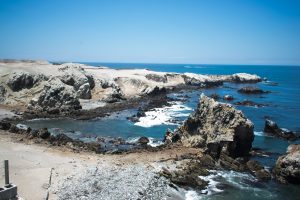
Looking over the wall into Punta San Juan. The dark patches on the peninsula are thousands of birds and penguins. Photo by Sebastian Romero Torres.
The wind whipped over and between the rocky dunes of the headland, and the three of us sheltered in the lee of the wall that cut across the spit. The call of cormorants and the roars of sea lions joined the sound of waves and wind to drown out our voices. We could hear them, but not see them. The thousands of birds, penguins, and mammals that we had come to see were hidden by the long concrete and barbed wire wall that snaked its way across the peninsula, protecting these vulnerable animals from people and predators alike. After days of travel, two journalists and myself had finally arrived at the Punta San Juan marine reserve on Peru’s southern coast. Or at least, we had reached the wall.
We hid from the wind and sun in the wall’s shadow and I helped the journalists set up their equipment: cameras, stabilizers, microphones, and other gadgets I’d never seen before. Just a few days before I was an ecologist thinking about kelp forests and ecosystem services in British Columbia, and now I was entirely out of my depth, on a different continent working with journalists on a very different kind of project. We had come to Peru to learn about the country’s fisheries, particularly what has historically been the world’s largest fishery: anchoveta.
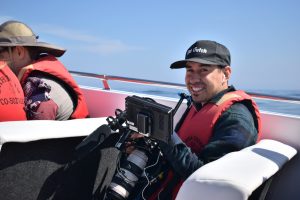
Journalist Jonathan Ventura and his confusing array of equipment. Photo by Sebastian Romero Torres.
As we finished setting up, our guide for the day drove up on his moped, dodging rocks and potholes on the sandy road. I jumped up as soon as he arrived, eager to enter the reserve and finally see the plentiful wildlife I could only hear from the outside. There had been a miscommunication though: he wasn’t expecting the cameras and was not happy to see them. After a lengthy conversation in Spanish that I couldn’t follow, our guide got back on his moped and drove back down the road. The two journalists just looked at me and shook their heads: “They won’t let us in.”
I was devastated. Not because we had spent so many hours getting to this remote part of Peru, and not even because I had really wanted to see the vulnerable Humboldt Penguins that used the reserve as a refuge. I was devastated because the birds and mammals which call Punta San Juan home were an important part of the story we were trying to tell about the anchoveta.
The anchoveta fishery is a critical piece of Peru’s economy. At its peak in 1971, more than 16 million tons of anchoveta were caught in Peru, more than any other fish species in the world. The anchoveta catches have declined since 1971, but anchoveta is still the first or second most caught fish every year. This small, oily fish from Peru is a major player in the global seafood supply.
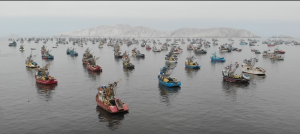
Countless anchoveta fishing boats sit waiting in Chimbote Harbour. Photo by Jonathan Ventura.
Humans aren’t the only beings who rely heavily on the anchoveta though. Peruvian seabirds and mammals such as seals and sea lions depend on anchoveta for up to 90% of their diet. As Anchoveta stocks have declined, so too have the populations of seabirds and mammals who eat them. Habitat loss, pollution, changing climate, and the loss of their main food source have created a perfect storm to threaten the populations of these animals. That’s why reserves like Punta San Juan are so important, and that’s why we were there.
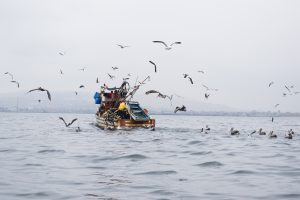
Guano Birds trail a fishing boat back into port, both fishers and birds compete for the anchoveta that frequent these productive coastal waters. Photo by Sebastian Romero Torres.
The journalists were much more used to this sort of roadblock than I was, and very quickly, we were on to plan B. The next day, we were 200 km north on a boat touring the Islas Ballestas, another important site for these at-risk species. Rather than thousands of Humboldt Penguins, we saw just a handful, but it was enough. Eventually, and with some effort, we were able to get the footage we needed to tell the story.
I’m still sad not to have seen Punta San Juan, and the remarkable abundance of life said to exist there, but hopefully I will get another chance to visit one day soon. And hopefully, the abundance of birds, penguins, seals, and sea lions will still be there when I do.
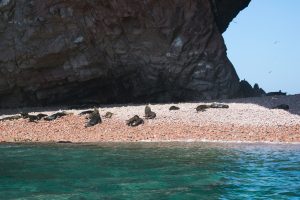
Sea lions pose for the camera on the Islas Ballestas. Photo by Jonathan Ventura.
Keep an eye on http://www.internationalreporting.org to learn more about the project as it unfolds in Spring / Summer 2019.
I would like to thank the Ocean Leaders and Global Reporting Programs at UBC for making this trip and project possible. I would also like to express my gratitude to my journalist colleagues who put up with a “scientist” always getting in the way and asking questions, as well as all the people in Peru and elsewhere who helped us along the way.
